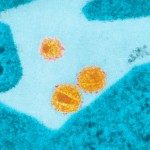Link to Pubmed [PMID] – 23302741
Link to DOI – 10.1128/CVI.00438-12
Clin Vaccine Immunol 2013 Mar; 20(3): 363-8
Six new human polyomaviruses have been identified since 2008 (Merkel cell polyomavirus [MCPyV], human polyomavirus 6 [HPyV6], HPyV7, HPyV9, trichodysplasia spinulosa polyomavirus [TSPyV], and Malawi polyomavirus [MWPyV]). The presence of specific antibodies against MCPyV, HPyV6, HPyV7, HPyV9, and TSPyV in 828 Italian subjects aged 1 to 100 years was investigated by virus-like particle-based enzyme-linked immunosorbent assays (ELISAs). The findings indicate that all of these new polyomaviruses circulate widely in humans, with seroprevalences in adulthood ranging from 39.4% for HPyV9 to 87.1% for MCPyV, and that primary exposure is most intense in childhood, with the exception of HPyV7 and HPyV9, for which the seroprevalence increased throughout life. The proportion of subjects with high antibody titers was found to increase with age for MCPyV and to decrease with age for TSPyV.

